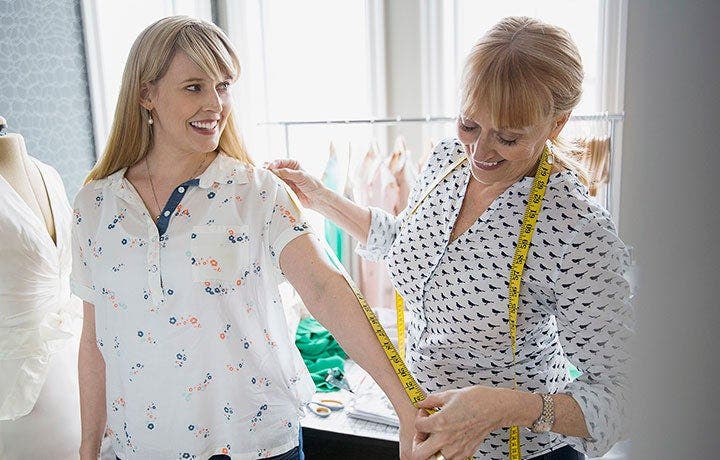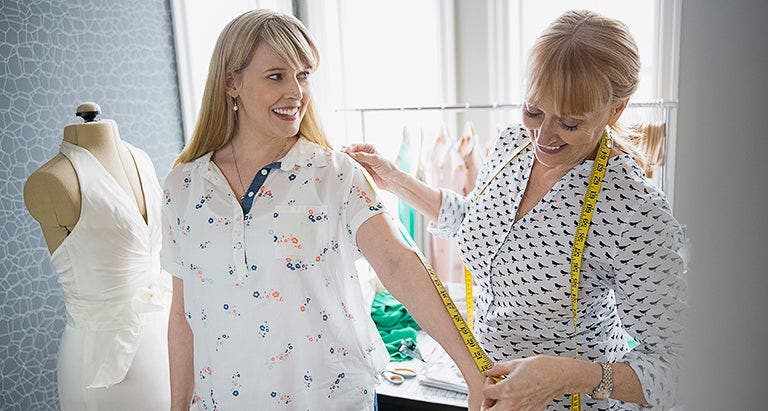Get a New Wardrobe Without Buying a Thing


The first time you pull on a pair of pants and realize they’re loose, it’s a fantastic feeling. That is, until you realize they’re sagging a bit in the butt, and you’re going to have to keep hiking them up on your hips every time you stand up throughout the day. So much for showing off your slimmed-down figure! Sure, you could hit the mall and buy new clothes, but unless you’ve hit goal, you probably don’t want to invest in an entirely new transition wardrobe. That’s where your local tailor comes in.
Whether you want to update a too-long dress, taper a coat that you loved 20 pounds ago, or take in a pair of go-to work pants, fine-tuning the fit of your clothes will give your wardrobe an upgrade and help you feel even better about your newly-shrinking body. Wayne Edleman, President and CEO of Meurice Garment Care in New York City, compares your relationship with a tailor to that with your hairstylist, adding, “It is their job to make you look and feel your best.”
Find the right tailor for the task.
Friends are a useful source for recommendations – the best tailor in the neighborhood might be your local dry cleaner! But you should also inquire at your favorite local boutique about who they trust for alterations. Make sure the tailor’s experience matches the alteration you need: Hemming pants and taking in seams is often simple, but more elaborate alterations, including reductions of a size or more, require an item of clothing to essentially be taken apart and remade. For these undertakings, finding a tailor with a strong background in construction, in addition to sewing, is key, says Shanan Teerath, owner of NYC boutique favorite Shanan Tailors.
Plan your fitting.
Make an appointment and come prepared, says Edelman: “along with the clothing you want to have altered, bring any specific undergarments (the proper bra, body shapers, etc.) and the shoes that you'll wear with it to ensure a flawless fit.” Some tailors, like those at Meurice, will make house calls. This can be a huge timesaver, especially if you have more than a few items that you are having altered. While fittings are usually included in the price of the alterations, be sure to ask ahead of time about any possible charge for this service to avoid any surprises on your bill.
Get the fit you want.
Speak frankly with the tailor about your vision. The tailor should be up front about what can and cannot be changed. He or she will measure, mark, and pin the garment on your body so you can get a strong sense of the end result. Teerath explains that a tailor should measure each leg or arm and mark them separately because most people are not exactly symmetrical. If a tailor just takes the measurement on one side and plans to replicate it on the opposite side, that’s a red flag.
Decide what pieces to get tailored.
Each piece of clothing and each body are different. As a result, “tailoring is more of an art than a science,” observes Edelman. Here he offers a few important factors that you should consider when choosing which items to have tailored:
- Fabric. Most common materials such as cotton, silk, wool and rayon are easy for a tailor to work with. Embellished fabrics with sequins or beading will be far more difficult to alter because such ornamentation needs to be removed during the process, and then reattached once the changes have been made. Boucle, lace and shearling are also more difficult to work with.
- Denim. Most tailors are able to maintain the original hem of a jean when altering the length to keep the look of the leg consistent. However, when denim with fading and distress are taken in at the seat and thighs, the proportions can become distorted, causing an unflattering result.
- Lining. While far greater detail is paid to the outer layer, the lining of a jacket, dress, pants or skirt must also be altered – so clothing that is lined essentially has to be tailored twice. This usually translates to a longer wait time and higher price.
- Sizing. Reducing the scale of a garment by one or more sizes often means taking it completely apart and remaking it. This, too, will take longer and cost more than a simpler alteration.
- Uncommon items. Down coats, bathing suits, and yes, even bras can be altered! Don’t assume something cannot be fixed – you’ll never know until you ask.
- Time. Turnaround depends on how busy your tailor is and can run anywhere from three days to two weeks. If you need something quickly ask up front about having it rushed, but expect to pay extra.
The Price of Perfection
Here is a general guide to basic alteration prices. Variations depend on your location as well as the material and construction of the garment.
- Pants hem: $8 and up
- Pants/Skirt waist only: $15 and up
- Pants/Skirt size reduction (waist, seat, and thighs): $25 and up
- Shirt/Blouse hem: $10 and up
- Shirt/Blouse sleeve hem: $10 and up
- Shirt size reduction (taken in at sides, back, and chest): $25 and up
- Jacket hem: $25 and up
- Jacket sleeve hem: $15 and up
- Jacket size reduction: $45 and up
RELATED: Cheap Ways to Build Your In-Between Wardrobe
